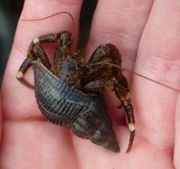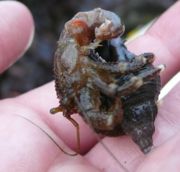Pagurus hirsutiusculus
From ize
Pagurus hirsutiusculus is commonly called the hairy hermit crab.
| Taxonomy | |
|---|---|
| Kingdom: Animalia | |
| Phylum: Arthropoda | |
| Subphylum: Crustacea | |
| Class: Malacostraca | |
| Subclass: Eumalacostraca | |
| Order: Decapoda | |
| Suborder: Pleocyemata | |
| Infraorder: Anomura | |
| Superfamily: Paguroidea | |
| Family: Paguridae | |
| Genus: Pagurus | |
| Species: P. hirsutiusculus (Dana, 1851) |
Contents |
Description
Adults range in color from olive green to brown to black. Distinguishing characteristics of this hermit crab are white and often also blue bands on the walking legs at the joint of the propodus and the dactyl. The antennae are grayish-brown with distinct white bands. This hermit crab is also easily identified by the remarkable amount of hair covering its body.
Size
The carapace of an adult P. hirsutiusculus may measure up to 19 mm in length.
Range and Habitat
P. hirsutiusculus is found from the Pribilof Islands, Alaska to southern California. They can be found from the middle intertidal zone to water depths of up to 110 meters. They are commonly found in tide pools with sand or rock, and under rocks, logs, and seaweed.
Diet
P. hirsutiusculus mainly feeds on detritus, but is an opportunistic feeder and also feeds on seaweeds.
Natural History
The right chela of P. hirsutiusculus is significantly larger than the left and is used primarily for defense. The smaller left chela is used for fine motor work such as eating and selecting gastropod shells. The setae on the minor chela are sensetive to calcium, and help the hermit to judge whether the gastropod shell will be adequate to suit its needs. As is common with hermit crabs, P. hirsutiusculus carries an abandoned gastropod shell to protect itself. Unlike many hermit crabs which seem to prefer shells into which they can completely withdraw, P. hirsutiusculus often chooses small gastropod shells that can be easily abandoned when it encounters a potential predator, using speed as its primary defense against predation. The primary predators of P. hirsutiusculus are sculpins.
Life History
The color pattern and hairiness of P. hirsutiusculus varies with age. A P. hirsutiusculus can be identified as female by the small pleopod appendages on the left side of her abdomen. She attaches her eggs to these pleopods after mating and may carry up to 5 broods through spring and summer.
References
- Duane, S. J. (1999). The Beachcomber's Guide t Seashore Life in the Pacific Northwest. (pp. 117). Maderia Park, B. C. Harbour Publishing.
- Jensen, G. C. (1995). Pacific Coast Crabs and Shrimps. (pp. 66). Montgomery, CA. Sea Challengers.
- Kozloff, E. N. (1993). Seashore Life of the Northern Pacific Coast, an Illustrated Guide to Northern California, Oregon, Washington, and British Columbia. (pp. 132). Seattle, WA. University of Washington Press.
- Lamb, A. and Hanby, B. P. (2005). Marine Life of the Pacific Northwest: A Photographic Encyclopedia of Invertebrates, Seaweeds, and Selected Fishes. (pp. 314). Maderia Park, B. C. Harbour Publishing.
- Mesce, K. A. (1993). Morphological and Physiological Identification of Chelar Sensory Structures in the Hermit Crab Pagurus hirsutiusculus (Decapoda). Journal of Crustacean Biology, 13, 95-110.



